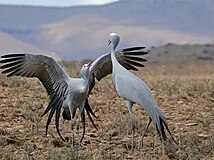Cranes are tall wading birds in the family Gruidae. Cranes are found on every continent except for South America and Antarctica and inhabit a variety of open habitats, although most species prefer to live near water.[1] They are large birds with long necks and legs, a tapering form, and long secondary feathers on the wing that project over the tail.[2] Most species have muted gray or white plumages, marked with black, and red bare patches on the face, but the crowned cranes of the genus Balearica have vibrantly-coloured wings and golden "crowns" of feathers.[1] Cranes fly with their necks extended outwards instead of bent into an S-shape (differentiating them from the similar-looking herons)[3] and their long legs outstretched. They also have musical, long-reaching calls and elaborate courtship displays.[2]
Cranes are threatened by habitat loss, intentional hunting, and the wildlife trade.[1] The Siberian crane, with an estimated population of 3,500–4,000 mature individuals, is considered critically endangered due to the construction of dams that threaten one of its main wintering grounds.[4] Two other species are considered endangered, seven are considered vulnerable, and one is considered near-threatened. The species with the smallest estimated population is the whooping crane, which is conservatively thought to number 50–249 mature individuals,[5] and the one with the largest is the sandhill crane, which has an estimated population of 450,000–550,000 mature individuals.[6]
There are currently 15 extant species of crane recognised by the International Ornithologists' Union distributed among four genera.[7] The cranes are most closely related to the family Aramidae, which contains a single extant species, the limpkin.[1][8] These two families, together with the trumpeters, rails, and finfoots, comprise the order Gruiformes.[7] Many species of fossil cranes are known from the Eocene onwards; however, their exact number and taxonomy are unsettled due to ongoing discoveries.[9]
- ^ a b c d Cite error: The named reference
cranesBOWwas invoked but never defined (see the help page). - ^ a b Cite error: The named reference
Grimskippwas invoked but never defined (see the help page). - ^ Cite error: The named reference
Armistead2015was invoked but never defined (see the help page). - ^ Cite error: The named reference
iucn-status-Leucogeranus-leucogeranuswas invoked but never defined (see the help page). - ^ Cite error: The named reference
iucn-status-Grus-americanawas invoked but never defined (see the help page). - ^ Cite error: The named reference
iucn-status-Antigone-canadensiswas invoked but never defined (see the help page). - ^ a b Cite error: The named reference
cranesIOCwas invoked but never defined (see the help page). - ^ Cite error: The named reference
limpkinBOWwas invoked but never defined (see the help page). - ^ Cite error: The named reference
cranesPDBwas invoked but never defined (see the help page).



